Wed., Feb. 28, 2007
Optional Assignment #3 was collected today together with the short, one
question, optional assignment question given in class on Monday. Here is the answer to that
question.
Today was the first of two 1S1P Assignment #2
due dates. You can also turn in a report (no more than one
report) on Friday this week. You can only turn in a total of 2
reports as part of this assignment. If you turned in two reports
on Wednesday you can't turn in any additional reports on Friday.
The Experiment #3 materials were
distributed for the first time in class today. The Experiment #4 materials should become
available next week.
A preliminary version of the Quiz #2 Study
Guide is now available online.
We need to
finish up a couple more energy balance type situations.
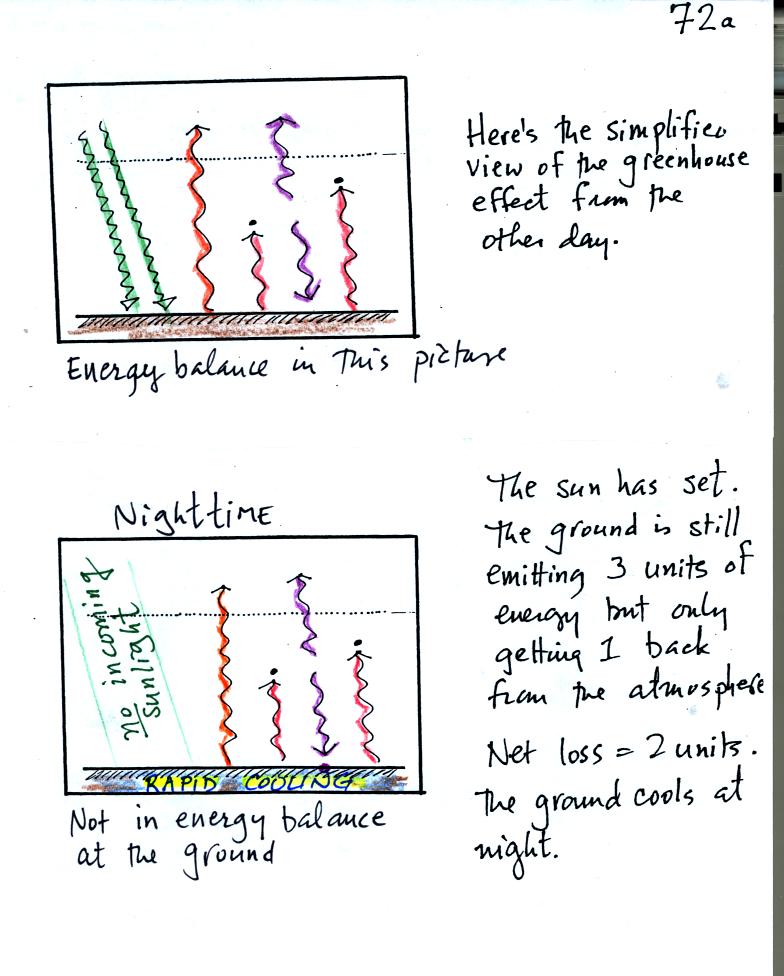
The top figure shows energy balance on the earth with an
atmosphere containing greenhouse gases.
We modify the figure somewhat in the bottom picture. The incoming
sunlight has been removed; something that happens at night. The
ground is emitting 3 units of energy
and getting 1 back from the atmosphere. That is a net loss of 2
units. The ground will cool fairly rapidly during the night.
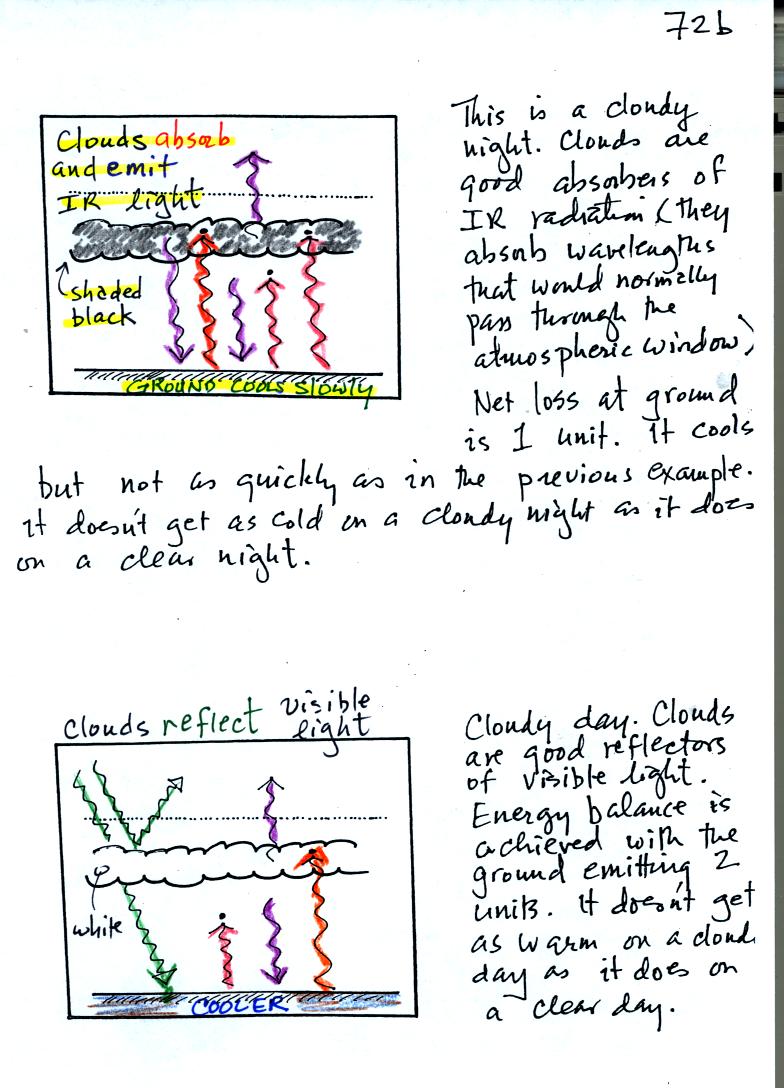
In the top figure it is still night but a layer of clouds
has been added. The clouds
are good absorbers of IR radiation even at wavelengths that would
otherwise pass through the atmosphere. If people were able to see
IR
light instead of visible light, clouds would appear black - it is
surprising how the appearance of something can change depending on the
kind of light you are able to see.
Clouds reduce the net loss
of energy at the ground. The ground still cools
but cools more slowly and doesn't get as cold during the night.
The bottom figure is a daytime figure (the green arrows of
sunlight are back in the picture ). The clouds will reflect some
of the incoming sunlight (this is what gives clouds their white
appearance) and
reduce the daytime high temperatures (you can tell it is cooler because
the ground is only emitting 2 arrows of IR energy).
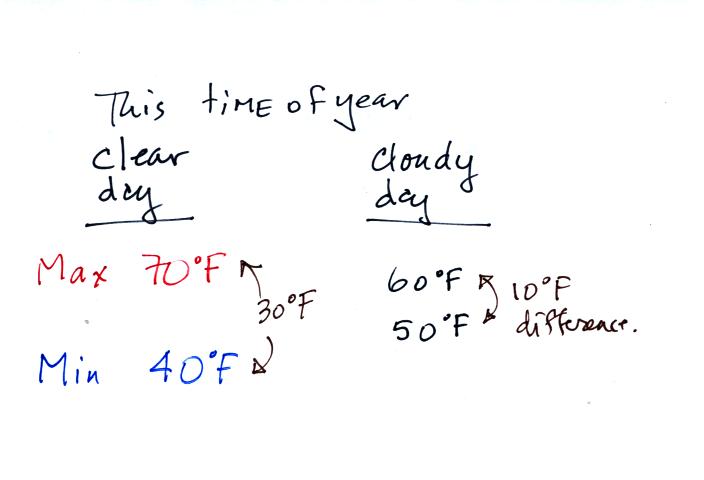
Typical daytime highs and nighttime lows in Tucson for this
time of year. Note how the clouds reduce the daily range of
temperature.
One last
thing before we leave energy transport, energy balance, and the
greenhouse effect.
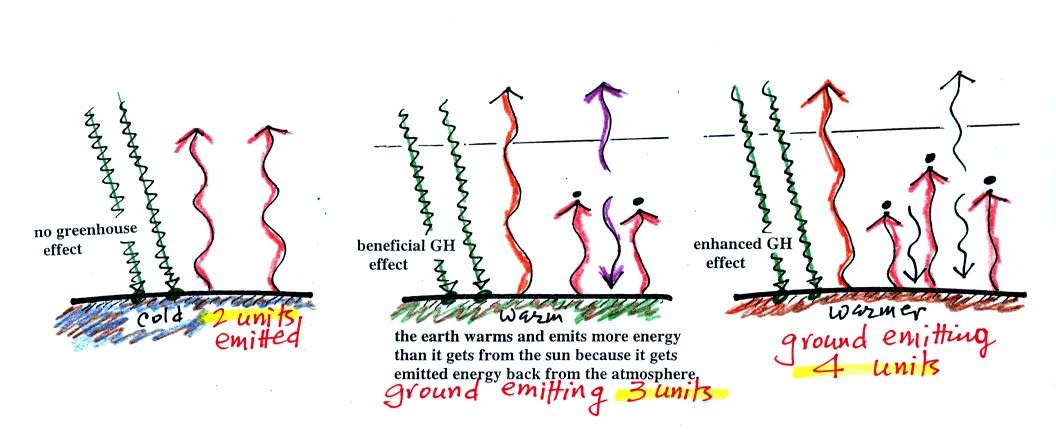
The figure on the left shows energy balance on the earth
without
an atmosphere or with an atmosphere that doesn't contain greenhouse
gases (so that IR energy emitted by the ground isn't absorbed by gases
in the atmosphere). The ground only needs to emit 2 units of
energy to reach energy balance. The ground wouldn't need to be
very warm to do this.
In the middle picture the natural greenhouse effect is in
operation. The ground is warmer and emitting 3 units of
energy. It can do this even though it is only getting 2 units of
energy from the sun because greenhouse gases absorb some of the emitted
energy and emit some of it back to the ground.
In the right figure the concentration of greenhouse gases has increased
(due to human activities). The ground has warmed even more (global warming) and is now
emitting 4 units of energy and still only getting 2 from the sun.
But with more greenhouse gases, the atmosphere is now able to absorb 3
units of the IR emitted by the ground. The atmosphere sends 2
back to the ground and 1 up into space.
The next figure shows a common misconception about the cause of global
warming
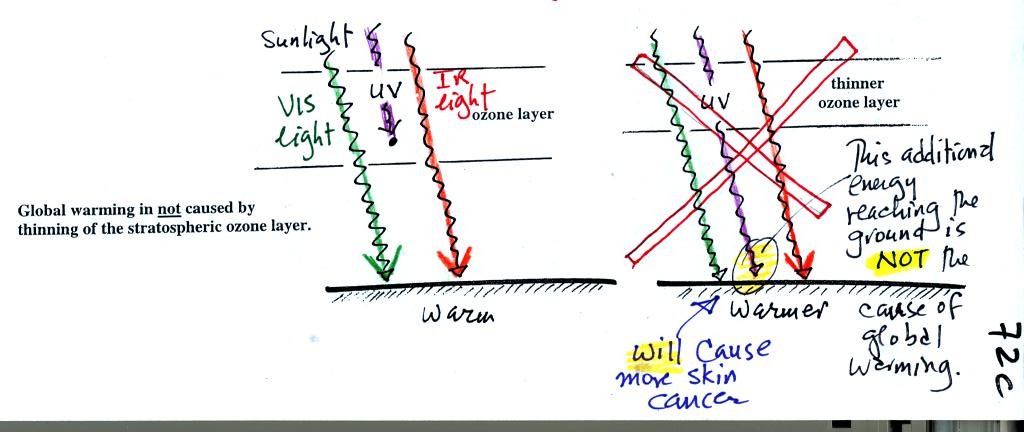
Many people know that sunlight contains UV light and that
the ozone
absorbs much of the dangerous type of high energy radiation.
People also know that release of chemicals such as CFCs are destroying
stratospheric ozone and letting some of this UV light reach the
ground. That is all correct. They then conclude that it is
this additional UV energy that is causing the globe to warm. This
is not correct. There isn't much UV light in sunlight in the
first place and the small amount of additional UV light reaching the
ground won't be enough to cause global warming. It will cause
cataracts and skin cancer and those kinds of problems but not global
warming.
Next up in
NATS 101 - Causes of the seasons
First some very basic information (that every college graduate should
know)
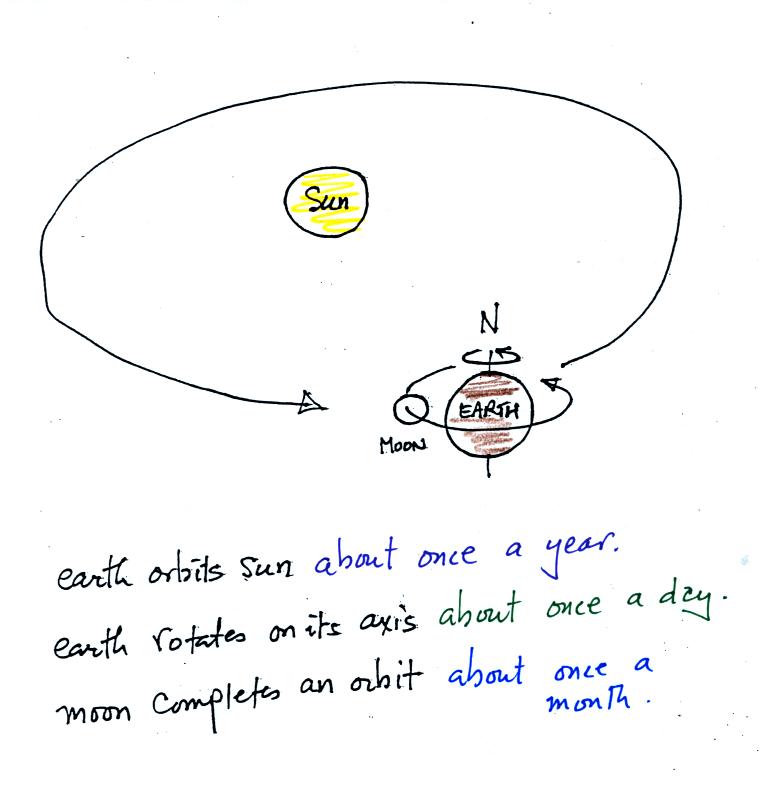
Many people would have missed the 3rd question. Many
people think
the moon orbits the earth in about a day. This is because they
see it in about the same position in the sky on successive
nights. We can see what actually happens in the next figure (not shown in class)
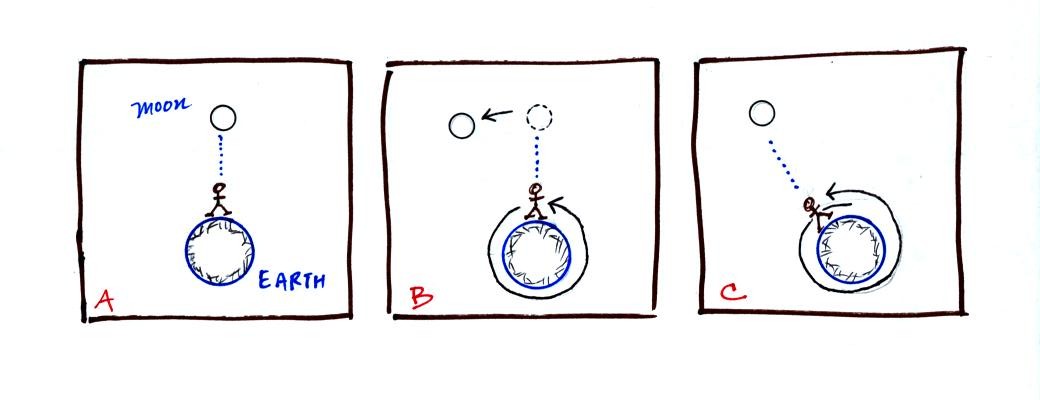
On the
first night in Fig. A the person looks up and sees the moon. One
day later on
night B, the earth has completed one rotation on its axis and the
person
is looking up at the same point in space. The person doesn't see
the moon in the same position as the night before; the moon has moved a
little bit in its orbit. In Fig. C, a little more than 24 hours
after Fig. A, the person again sees the moon overhead. If you
were to make a note of the time the moon rises you would notice it
rises a little later each successive night.
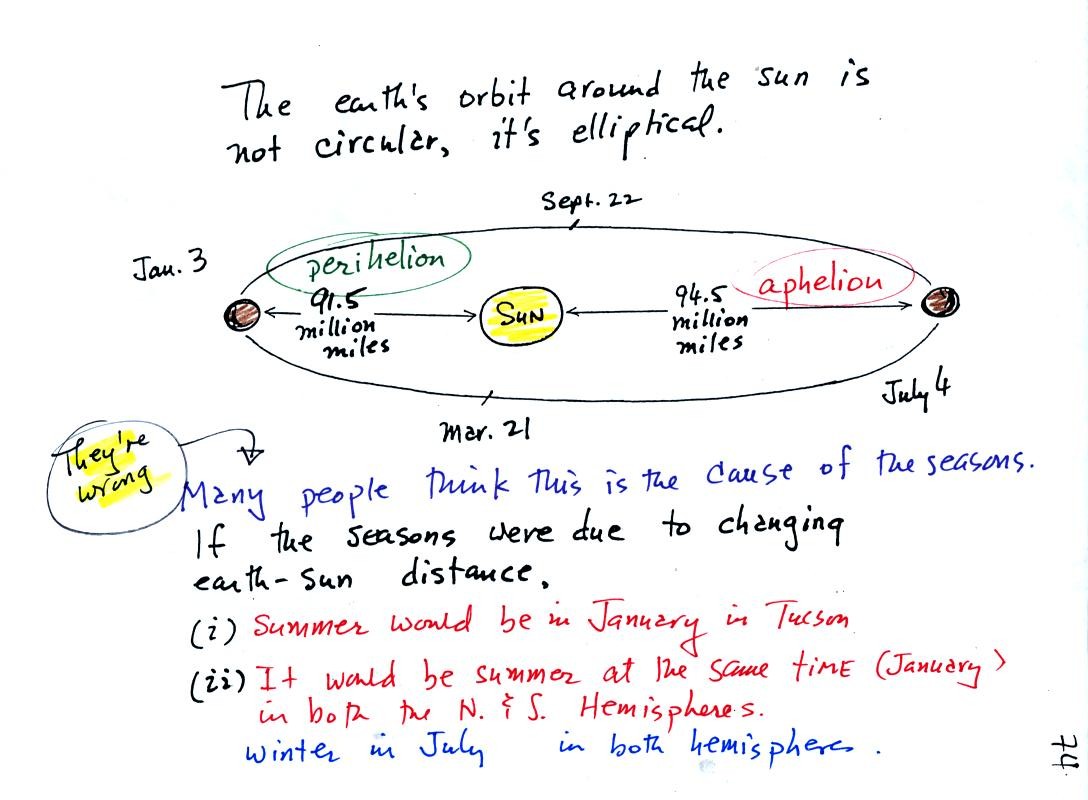
Many people know that the earth's orbit around the sun is
not circular and that the distance between the earth and sun changes
during the year. Many people think this is the main cause of the
seasons. The earth is closest to the sun on the perihelion.
The earth is closer to the sun in January than in
July. If
this were the main cause of the seasons, summer in Tucson would be in
January and winter would be in July. Summer and winter would both
occur at the same times in both hemispheres. Neither of these is
true. The changing
distance
between the earth and the sun has an effect but is not the main cause
of seasonal changes.
The main cause of the seasons is the fact that the earth is tilted with
respect to its orbit around the sun. This is shown in the next
figure.
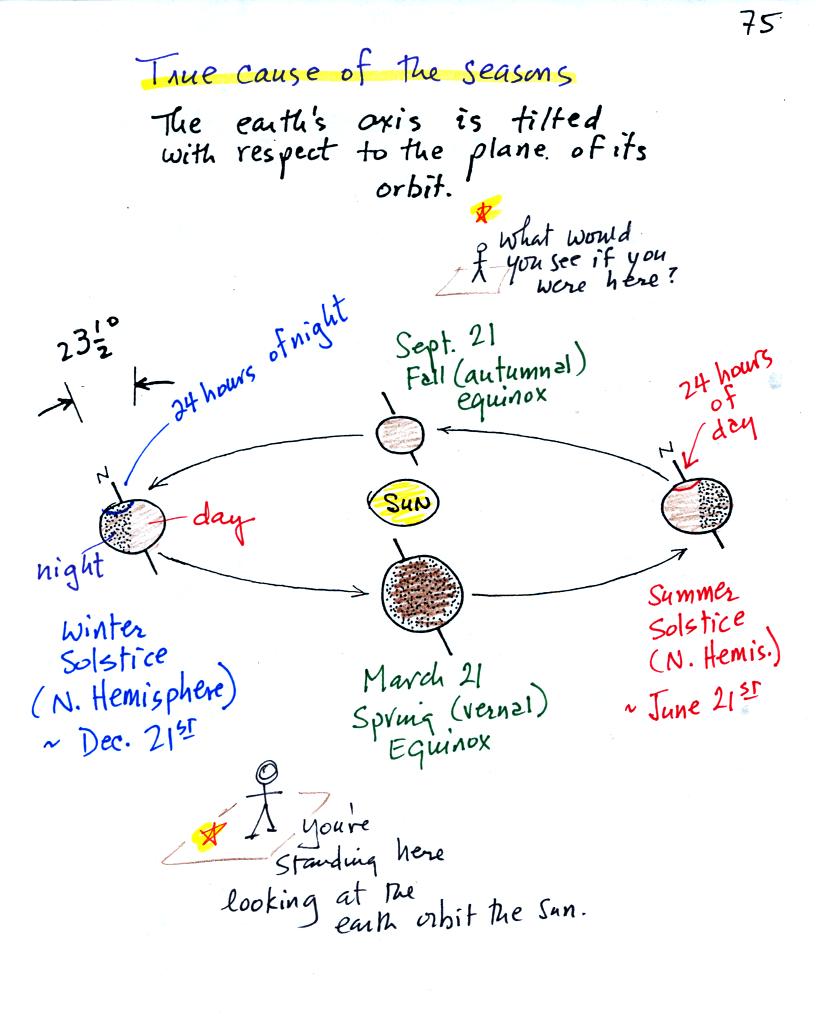
This figure shows the tilted earth at four locations in its
orbit around the sun. You should be able to start with a blank
sheet of paper and
draw a
picture like this. Note how the N. Pole tilts away
from the sun
on Dec. 21st, the winter solstice. The N. Pole is tilted toward
the sun on June 21. Those are good places for you to
start your sketch. You should also be able to name and attach a
date to each of the four locations.
Before going on, try to imagine what this picture would like if you
moved to the other side of the scene and looked back toward the
sun. Click here for a
sketch.
Seasons on the earth are caused by the changing orientation of the
earth relative to the sun. The figure above doesn't really
explain why this is true.
We barely had enough time to cover the top of p. 76
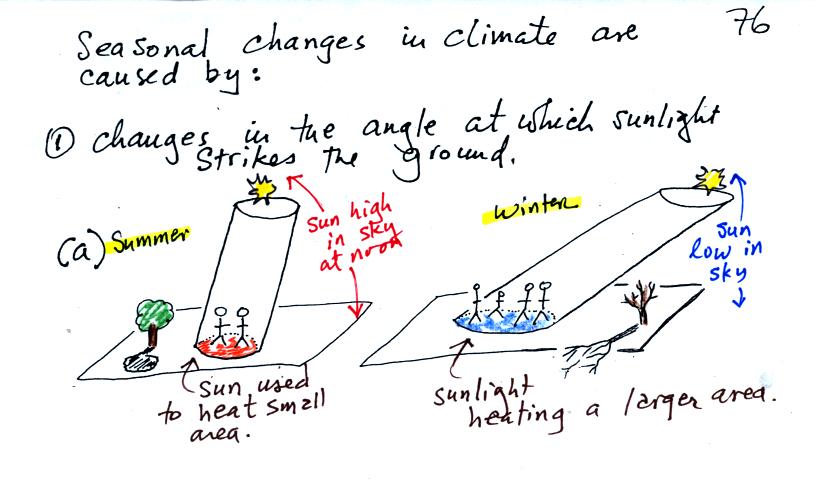
In the summer when the sun reaches a high elevation angle
above the
horizon, an incoming beam of sunlight will shine on a small area of
ground. The ground will get hot. The two people sharing the
shaft of summer sunlight will get a sunburn.
In the winter the sun is
lower in the sky. The same beam of sunlight gets spread out over
a larger area. The energy is being used to try heat a larger
amount of ground. The result is the the ground won't get as
hot. 4 people are able to share the winter sunlight and won't get
burned as quickly.
We viewed
a couple of short video experiments showing the solar irradiance
experiment (Experiment #3). You'll find some information about
that experiment here.









